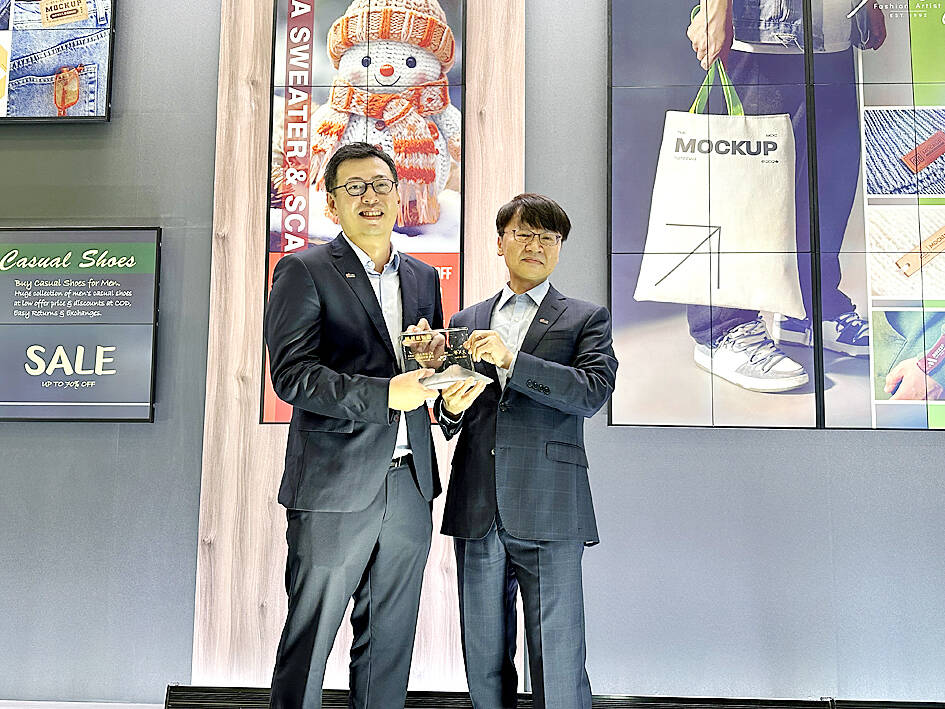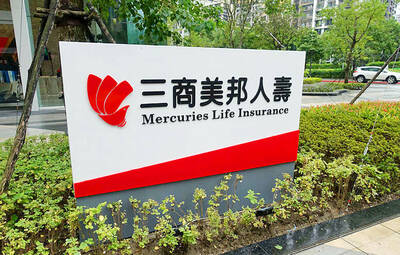E Ink Holdings Inc (元太科技), the world’s largest e-paper display supplier, yesterday reported a 25 percent annual decline in net profit for last quarter as a bumpy transition to better color displays for electronic shelf labels (ESLs) led to a supply chain glut.
Module customers were still grappling with excessive inventory last month, leading to a decline in the company’s Internet of Things (IoT) business, which primarily produces ESL e-paper displays, E Ink said.
Net profit sank to NT$1.32 billion (US$40.9 million) during the three months to March, from NT$1.76 billion over the same period last year. Earnings per share dropped to NT$1.16 from NT$1.54.

Photo: Chen Mei-ying, Taipei Times
Operating profit plunged 54 percent annually to NT$833 million from NT$1.81 billion, but non-operating income grew 95 percent to NT$879 million, including foreign exchange gains of NT$497 million, helping to bolster the firm’s bottom line, E Ink said.
“Looking forward, the IoT business will return to the normal growth path in the third quarter and that growth will extend into the fourth quarter,” E Ink chairman Johnson Lee (李政昊) told investors at a quarterly conference yesterday, adding that the firm’s downstream partner, Walmart Inc, plans to implement its ESL installment project at the end of this year, ahead of schedule.
Regarding e-paper displays for e-readers, growth momentum is robust and better than expected, indicating a smooth switch to color e-readers from black and white, Lee said.
E Ink has noticed that supply of new colored e-paper displays made on Kaleido 3 technology is constrained, he said.
The company retains its positive outlook for this year, expecting revenue to grow every quarter going forward, he said.
“The most important thing is that we have at least ridden through the trough period,” Lee said. “The second quarter is better than the first quarter, and we believe the third quarter will be better than the second.”
E Ink said that it has expanded capacity to produce large e-paper displays for digital signage used in retail stores or for outdoor advertising, and expects to ramp up production by the end of this year.
The firm said it has budgeted NT$5 billion to NT$6 billion of capital expenditure for this year.

France cannot afford to ignore the third credit-rating reduction in less than a year, French Minister of Finance Roland Lescure said. “Three agencies have downgraded us and we can’t ignore this cloud,” he told Franceinfo on Saturday, speaking just hours after S&P lowered his country’s credit rating to “A+” from “AA-” in an unscheduled move. “Fundamentally, it’s an additional cloud to a weather forecast that was already pretty gray. It’s a call for lucidity and responsibility,” he said, adding that this is “a call to be serious.” The credit assessor’s move means France has lost its double-A rating at two of the

AI BOOST: Although Taiwan’s reliance on Chinese rare earth elements is limited, it could face indirect impacts from supply issues and price volatility, an economist said DBS Bank Ltd (星展銀行) has sharply raised its forecast for Taiwan’s economic growth this year to 5.6 percent, citing stronger-than-expected exports and investment linked to artificial intelligence (AI), as it said that the current momentum could peak soon. The acceleration of the global AI race has fueled a surge in Taiwan’s AI-related capital spending and exports of information and communications technology (ICT) products, which have been key drivers of growth this year. “We have revised our GDP forecast for Taiwan upward to 5.6 percent from 4 percent, an upgrade that mainly reflects stronger-than-expected AI-related exports and investment in the third

Mercuries Life Insurance Co (三商美邦人壽) shares surged to a seven-month high this week after local media reported that E.Sun Financial Holding Co (玉山金控) had outbid CTBC Financial Holding Co (中信金控) in the financially strained insurer’s ongoing sale process. Shares of the mid-sized life insurer climbed 5.8 percent this week to NT$6.72, extending a nearly 18 percent rally over the past month, as investors bet on the likelihood of an impending takeover. The final round of bidding closed on Thursday, marking a critical step in the 32-year-old insurer’s search for a buyer after years of struggling to meet capital adequacy requirements. Local media reports

RARE EARTHS: The call between the US Treasury Secretary and his Chinese counterpart came as Washington sought to rally G7 partners in response to China’s export controls China and the US on Saturday agreed to conduct another round of trade negotiations in the coming week, as the world’s two biggest economies seek to avoid another damaging tit-for-tat tariff battle. Beijing last week announced sweeping controls on the critical rare earths industry, prompting US President Donald Trump to threaten 100 percent tariffs on imports from China in retaliation. Trump had also threatened to cancel his expected meeting with Chinese President Xi Jinping (習近平) in South Korea later this month on the sidelines of the APEC summit. In the latest indication of efforts to resolve their dispute, Chinese state media reported that